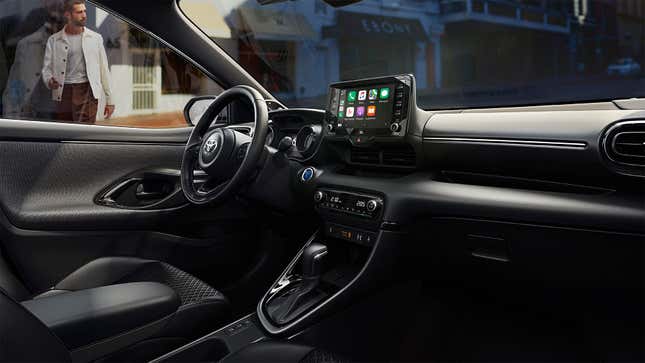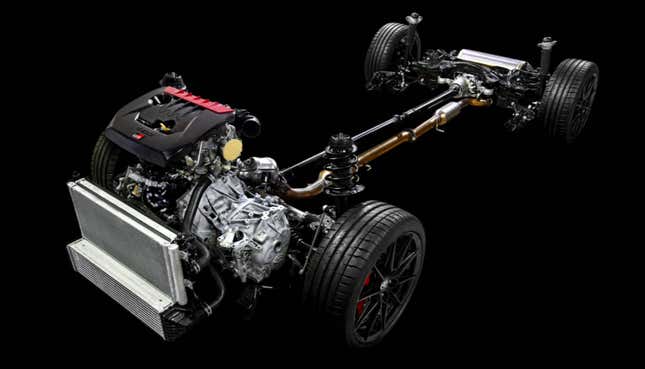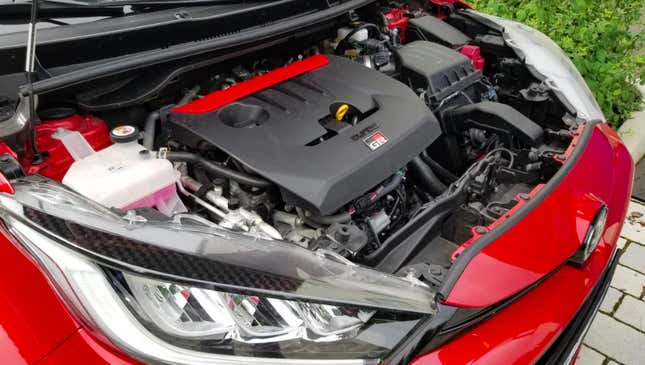The Toyota GR Yaris wasn’t even on my radar until last week. I’d seen a few headlines about the all-wheel drive subcompact, but that was about it. Last week, though, I found myself at the German Car Of The Year test event near Frankfurt, Germany, and among the 50-ish cars there for journalists to drive was the little red hatchback you see here. I chucked it around Franconia, and now I just have to tell you about it. Because the machine is incredible.
I won’t be able to give you a full review, as I only had an hour to drive the GR Yaris, but I’d be a fool to drive this not-for-the-U.S. monster-hatchback and just keep all my thoughts to myself. So here’s a little download of what it was like driving the 257 horsepower, all-wheel drive, 1.6-liter three cylinder turbo Toyota GR Yaris:
Upon first setting my eyes on the car, I realized that there’s really very little about the GR Yaris that looks special. Sure, the fascia and sheetmetal are a bit different than what’s on the standard Yaris (and there are two fewer doors), but honestly, the changes aren’t that dramatic to the layperson. Here’s the standard Yaris available in Europe:

On the inside, the car doesn’t look particularly special, either. Here’s the GR:

And here’s the regular Yaris:

These commonalities aren’t too surprising given the fact that the GR Yaris is a homologation special developed specifically to allow Toyota to race a three-door hatchback in the WRC (WRC requires that race cars be based on road cars). Making the GR Yaris completely different than the existing Yaris would have added cost, and the project was already an expensive endeavor, as Road & Track wrote in its piece The GR Yaris Homologation Special Broke All of Toyota’s Rules:
Clark explained to Road & Track that cars homologated for the WRC must have the same basic bodyshell as a production car. Toyota’s WRC team, and especially its team principal, rally legend Tommi Mäkinen, wanted a three-door with a lower roofline, a wider rear track, and double wishbones replacing the regular Yaris’ torsion beam rear. Doing all of this required Toyota to combine two different platforms—the front comes from the new Yaris’ GA-B platform, while the rear is based on the GA-C platform that underpins the Corolla, among other cars.
This was an expensive endeavor, and not something Toyota would typically undertake for a relatively niche performance model. But Mr. Toyoda wasn’t bothered by spending a little extra to ensure the brand would have a competitive rally car for 2021.

So lots of the skin and cabin looks familiar and doesn’t blow me away. Even when I got underway and began rowing from first to third gear as I headed out of town, I remained underwhelmed. “I guess it’s okay,” I thought initially.
Then I arrived in the countryside, smashed the accelerator pedal to the floor, and everything changed.

Above 4,000 RPM, the 1.6-liter three-cylinder turbo engine sings beautifully to the heavens, and all four wheels receive so much torque relative to the vehicle’s meager curb weight that I found myself driving over 100 mph on 62 mph country roads without even realizing it. Toyota claims a minimum zero to 60 mph time of 5.5 seconds, but that doesn’t quite seem right based on my drive. Even Motor Trend said in its review that the car feels quicker than the numbers suggest, writing:
All-wheel drive and a weight-to-power ratio that’s not far off that of a Porsche Boxster means good performance. Toyota claims a 0-62 mph time for the GR Yaris of 5.5 seconds. Top speed is electronically limited to 143 mph. It feels quicker.
[...]
You’ll climb out of the GR Yaris after a blast down your favorite driving road grinning with delight at just how eager, communicative, balanced, and accomplished this little car feels. You’ll stare at the badge and shake your head: This is a Toyota?!! Then you’ll remember that the top-spec Circuit Pack model costs less than two-thirds the price of a Ford Mustang Shelby GT500 and 40 percent the price of a Porsche Cayman GT4, two of the best driver’s cars you can buy for $100,000 or less. And you’ll burst out laughing.

The 2,900-ish pound car just feels so small and nimble, and yet incredibly stable at higher speeds in turns. The steering feels great, offering the right weight and feel (I won’t pretend to be an expert on steering feel, though. I’m not a performance car driver, usually), and the brakes — four-pistons up front, two in the back — are fantastic, bringing the little Toyota to a halt without too much pedal effort.

There is a bit of understeer initially when entering a corner, but the car’s limits are so high that I found myself driving endlessly around tight German traffic circles, marveling at the high speeds I could maintain without losing grip. It’s a miracle I wasn’t jailed.

The sound, though augmented via synthetic speaker tones, is awesome, and the six-speed shifter could not be more perfect. The shifts are short, they offer great feedback when going into gear, and the clutch pedal offers just the right amount of lightness and resistance— I wouldn’t change a thing about this transmission.

The car is far from perfect, of course. The engine idle from that three-cylinder engine is rough. Sitting at a stop light with the shifter in neutral and the motor running, I noticed the whole car vibrating like a 1995 Honda Accord with a loose spark plug wire.
Also, visibility out of the back window is horrid (see image above), it’s difficult for the driver (at least a short one like me) to reach their seatbelt on the B-pillar, and storage room behind the rear bench is laughable:

I’ll provide further insight if I ever get a chance to sit behind the wheel for more than just an hour, but even after just a short stint behind the wheel, I am confident that the GR Yaris will go down as one of the great hot-hatches of all time. It’s quick, loud, equipped with a fantastic shifter, reasonably lightweight, and phenomenally nimble. It’s a true sports car disguised as a utilitarian hatchback, and that’s just cool.